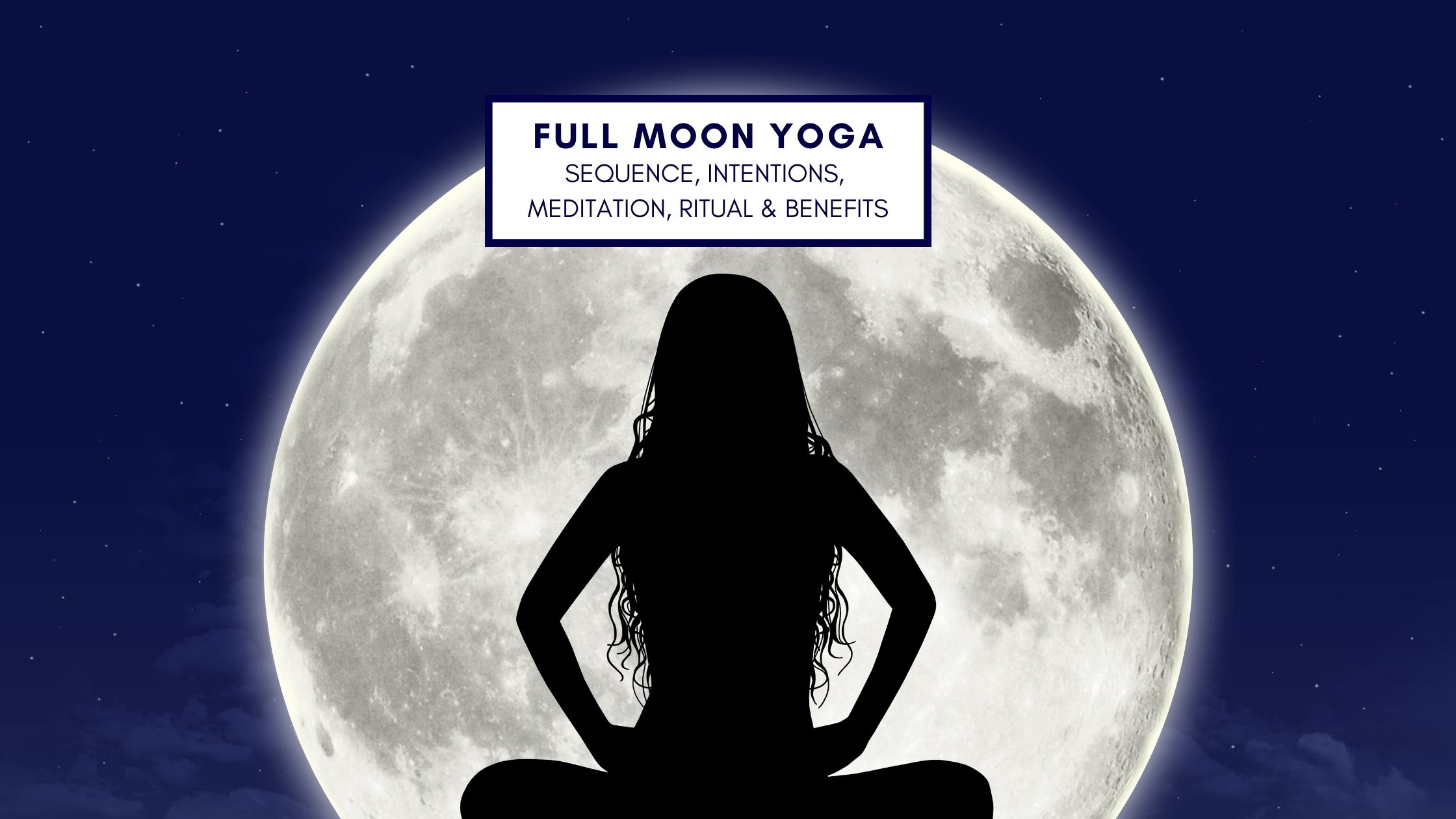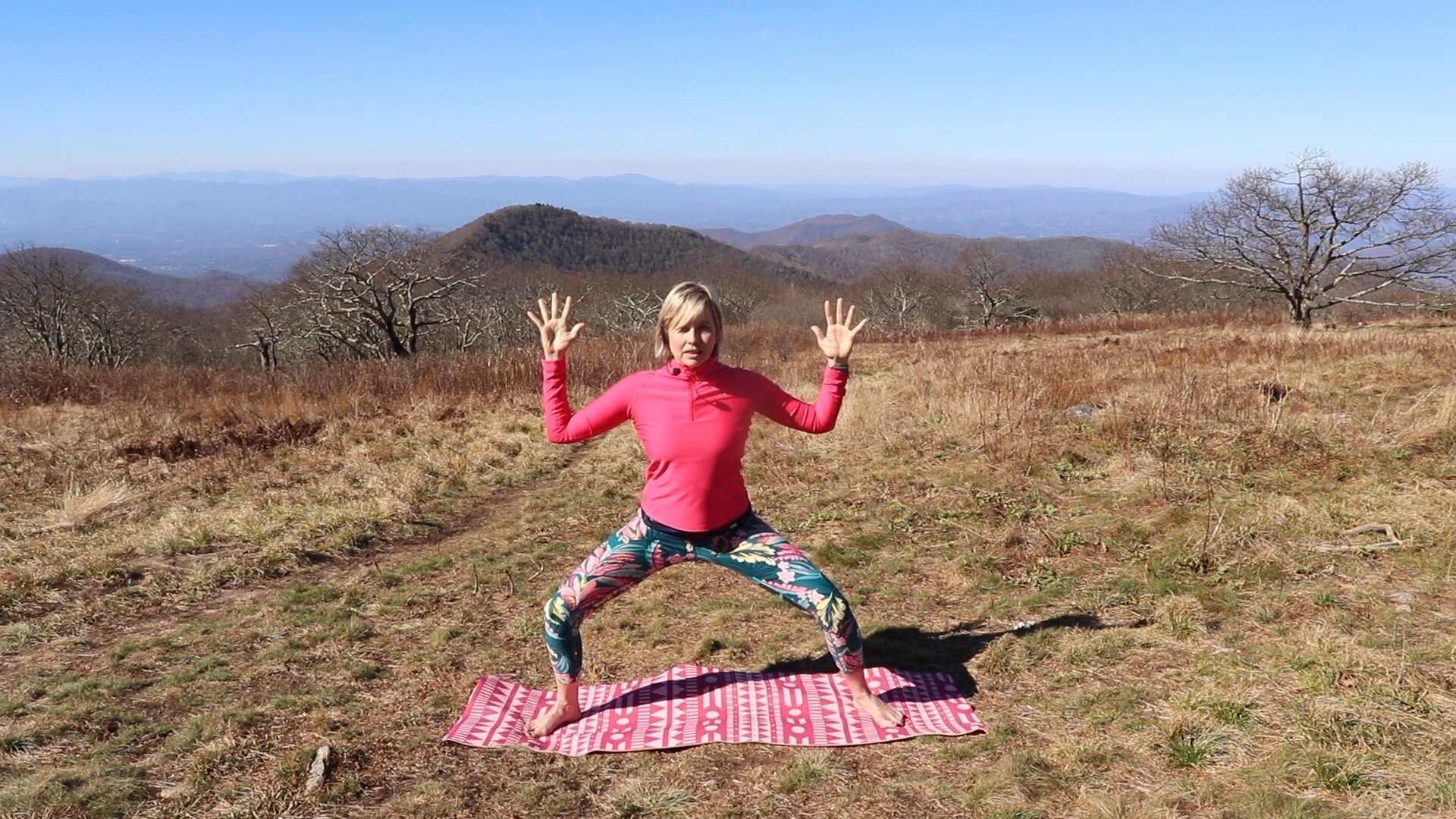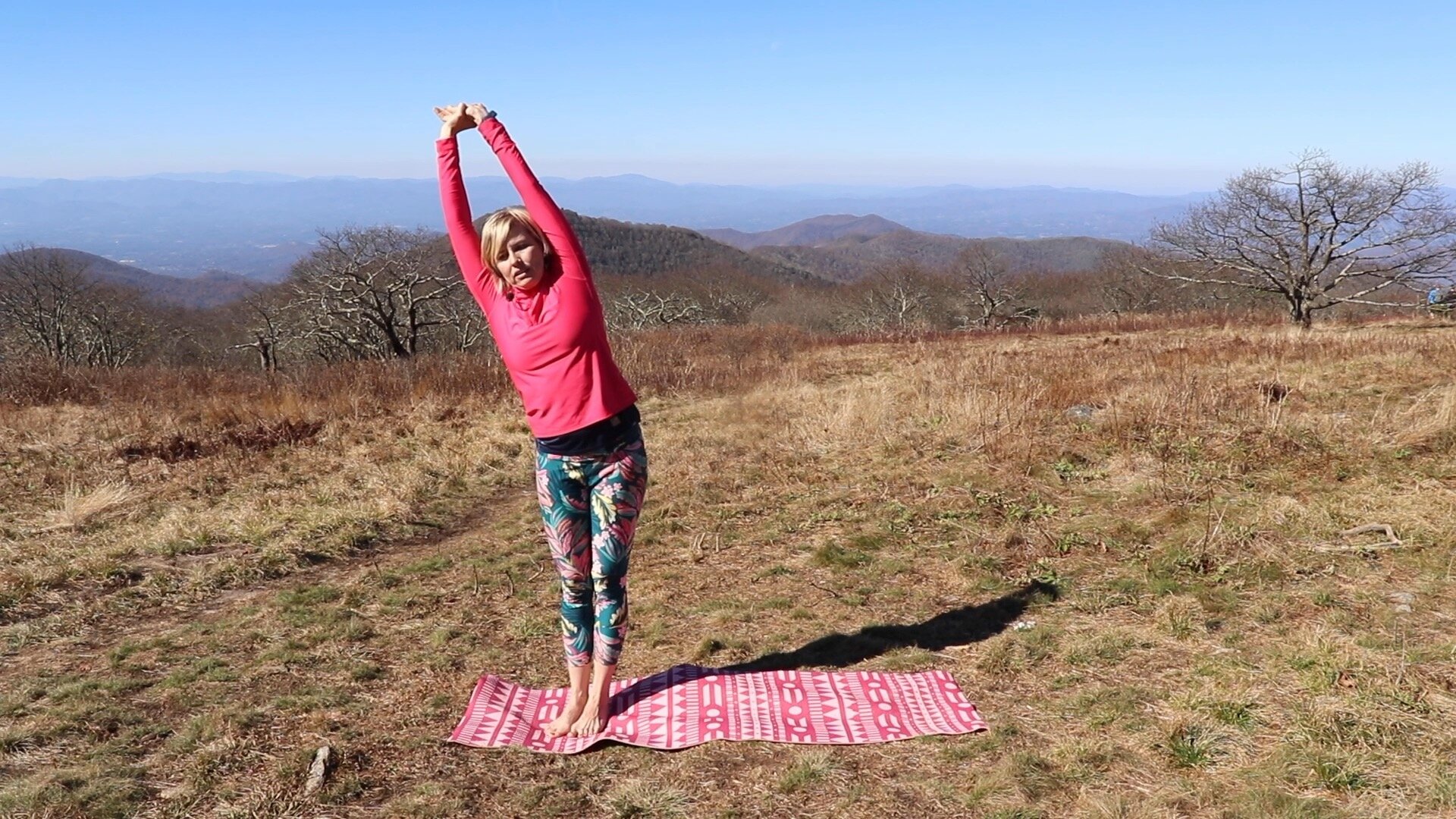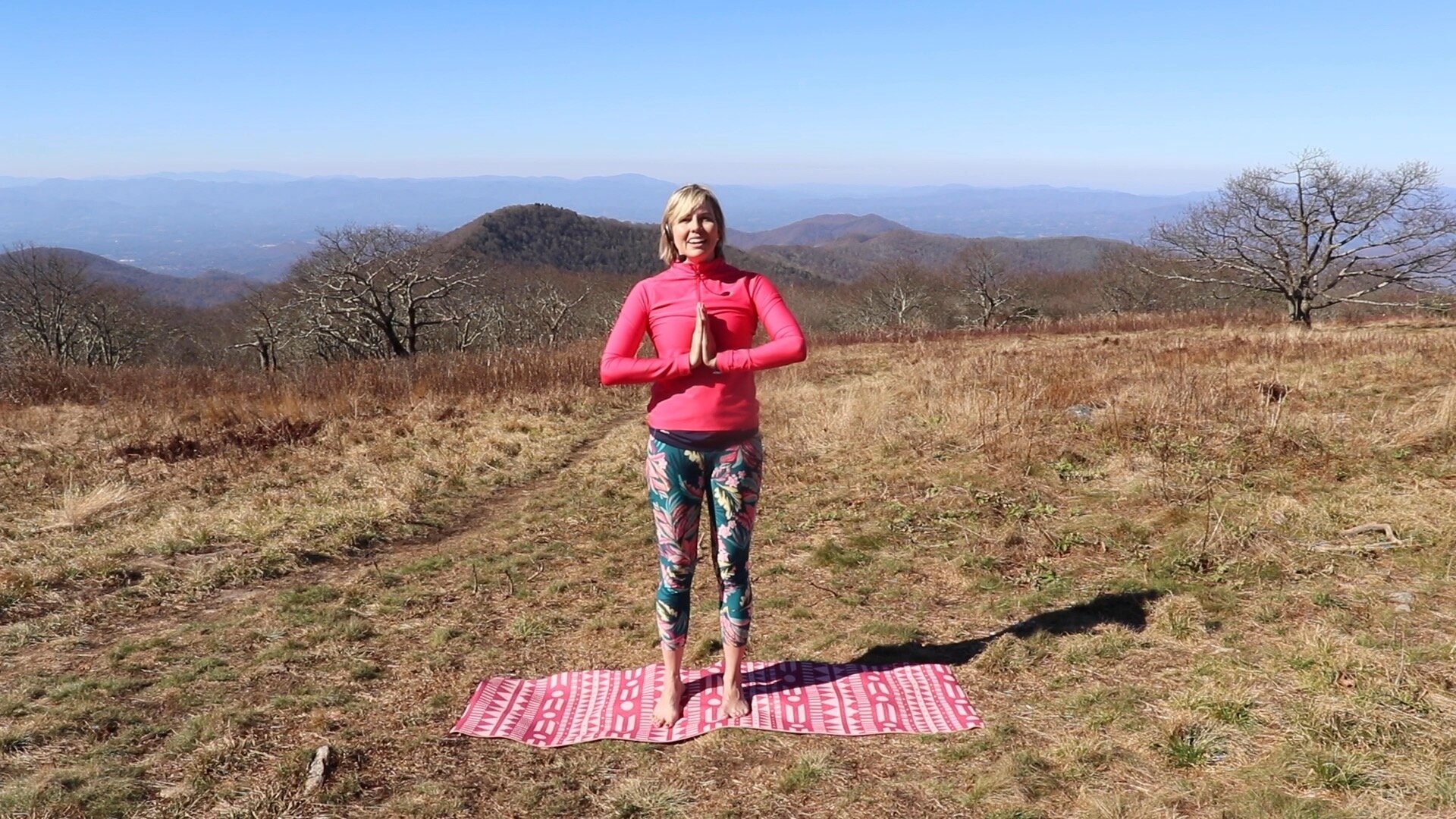Full Moon Yoga: Sequence, Intentions, Meditation, Ritual & Benefits to Help You Let Go
Jump to:
▶️ Full moon yoga sequence step by step + video
🌕 Full moon yoga meaning
🌕 Full moon yoga benefits
🌕 When is the next full moon
🌕 Full moon intention setting journaling ritual
🌕 Full moon yoga meditation mantra
▶️ 30 minute full moon yoga nidra guided relaxation video
🌕 Simple modern practical full moon rituals to clear clutter, negative habits and energy
🌕 Traditional full moon names
🌕 Full moon yoga hiking experience asheville nc
Yoga is inspired by nature.
Most of the poses and sequences are named after plants, animals and celestial bodies.
You’ve most likely heard of Sun Salutations or Surya Namaskar in Sanskrit. This yoga sequence represents the rising and setting of the sun and are traditionally practice facing East where the sun rises each day.
There are a few different variations of sun salutations in traditional yoga practices such as Hatha Yoga and Ashtanga Yoga and even more modern Vinyasa Yoga.
Full Moon Yoga Sequence
There is also a Full Moon yoga sequence called Moon Salutations or Chandra Namaskar in Sanskrit. It represents cycling through the phases of the moon.
🌑 🌒 🌓 🌔 🌕 🌖 🌗 🌘
We typically move forward and backward on our mats during a yoga practice. This moon salutation sequence moves side to side, which intentionally disrupts your energy and usual yoga sequence/routines in a good way!
Full Moon Yoga Meaning
In yoga, the sun, solar energy and the right side of the body is considered masculine. Masculine energy is fast, warm, energizing, more disciplined.
The moon, lunar energy and the left side of the body is considered feminine. Feminine energy is slow, cool, relaxing, more flowing.
Full Moons are a time to embrace more feminine energy for both men and women.
The Full Moon is the time to let go of what no longer serves you physically, mentally, emotionally or spiritually.
Full Moon yoga benefits include :
• Self-care/self-reflection,
• Releasing unwanted energy and
• Staying connected to Nature.
🌕 When is the next Full Moon?
The full moon (or lunar phase cycle) happens once every 29.5 days or roughly once per month.
On rare occasions, two full moons may happen in the same month. The second full moon within the same month is called a Blue Moon. Hence the saying “Once in a Blue Moon” is used to describe events that hardly ever happens.
Full Moon Intentional Setting Journaling Ritual
You’ll need: Paper/journal, pen/pencil, Yoga mat, blanket(s), + pillows/cushions and any other props to make you feel comfortable
The Full Moon is the time to let go of what no longer serves you physically, mentally, emotionally or spiritually.
Examples include: physical objects, habits, behaviors, relationships and thoughts.
What is the first thing that comes to mind that you feel a need to release right now? It is often something that makes you feel heavy/anxious/angry/fearful/self-loathing. Set a timer for 1, 3 or 5 minutes and write about whatever comes to mind.
Full Moon Yoga Meditation Mantra: Let Go
Sit comfortably on your yoga mat or a cushion/pillow and close your eyes. Visualize the thing that you want to release. It can be the actual thing or a word or object that represents that thing.
Breath deeply and slowly and think silently to yourself “Let” on the inhale and “Go” on the exhale. Inhale “Let”, Exhale “Go.”
You can set a timer for 3-5 minutes or just repeat as many times as you intuitively feel are needed.
You can go straight into the Yoga Nidra practice after this; especially if practicing in the evening/darkness.
Optional: If you want a little movement before laying down for 30 minutes, you can practice some Moon Salutations (Chandra Namaskar).
30 Minute Full Moon Yoga Nidra
Write the thing you want to let go of on a scrap or loose piece of paper. Fold it and keep it next to your mat.
Lay down on your mat and get comfortable - but not TOO comfortable. Cover up with a blanket as your body feels cooler when it finds stillness.
The word “Nidra” translates to sleep, but you don’t want to completely fall asleep and lose consciousness during this practice.
This guided practice is best using headphones, but speakers can work in a quiet room as well.
After you are finished listening to the guided practice, sit up and find the scrap/loose piece of paper you wrote on before. Get rid of it. If you can safely burn it, do so. Otherwise, rip it up with your hands and toss it or shred it with a shredder.
Set a timer for 5, 10 or 15 minutes and journal about your Yoga Nidra experience, any new insights and how much you were able to let go of the thing.
Repeat this ritual as many times as needed to really let go of what needs to be released. It’s most effective during a full moon but you can practice this any time.
More Simple / Modern / Practical Full Moon Rituals to Clear Clutter, Negative Habits and Energy
Unsubscribe from email lists you no longer read
Unsubscribe from automated or streaming services you don’t use
Disconnect from all your screens for the day (TV, computer, phone, tablet, etc.)
Don’t check your social media for a day
Clean out your junk drawer
Donate clothes you no longer wear
Take a warm bath with epsom salts
Pay off and/or cancel a unused credit card
Clean out your fridge
Clean out your pantry
Clean up a cluttered area of your home
Clean out & wash your car
Write down and reflect on 3 accomplishments from this cycle
Cross something off your to-do list that’s been on there for a while
Get a haircut
Clean off your computer desktop
Delete unused apps on your phone/computer
Clear the clutter out of your email inbox
Clean out your purse or wallet
Weed your garden
Get a massage
Finish reading a book
Clean out your garage
Prune your houseplants
Shred or clear out your junk mail / paper pile
Break down & recycle cardboard boxes used to ship online orders
Do a one day detox by drinking only water and eating only whole, healthy foods for the day
Vacuum your home/clean the floors
Do extra laundry, especially bed linens & things that aren’t washed as often
Mow the lawn
Clean your home windows (inside or outside)
Give your dog a bath
Sweat it out in a sauna
Take a cold plunge in a pool, river or waterfall
Pick up trash around your neighborhood or a nearby park/trail
Throw out & replace old socks & underwear
Organize your kid’s closets/clothes/toys & donate what y’all don’t need
Clean your baseboards
Clean tubs/toilets/sinks in your bathroom
Unfollow/unfriend accounts on social media that stress you out
Restart your phone
Clear out old/bad photos on your phone (blurry, duplicates, screenshots, etc)
Each Moon has a traditional name that is also inspired by Nature:
January Full Moon = Wolf Moon
February Full Moon = Snow Moon
March Full Moon = Worm Moon
April Full Moon = Pink Moon
May Full Moon = Flower Moon
June Full Moon = Strawberry Moon
July Full Moon = Buck Moon
August Full Moon = Sturgeon Moon
September Full Moon = Corn Moon or Harvest Moon
October Full Moon = Hunter’s Moon
November Full Moon = Beaver Moon
December Full Moon = Cold Moon
Learn more about the traditional Full Moon name meanings.
Namaste & Have A Great Day!
💖 Miranda





















































